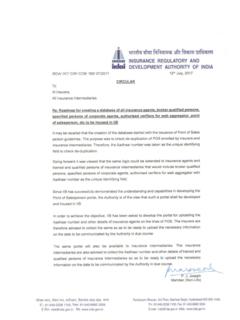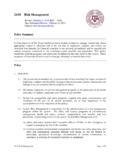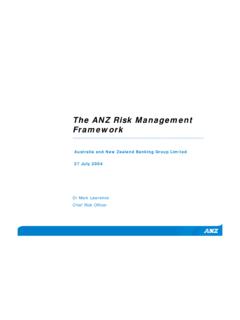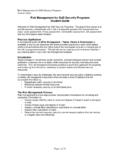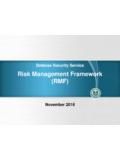Transcription of Risk Based Capital - Better Management for Better …
1 Risk Based Capital - Better Management for Better ResultsJuly 2009 Volume VII, No. 7 fl U fl U 2007 Insurance Regulatory and Development reproduce with due explicitly stated, the information and views published in thisJournal may not be construed as those of the Insurance Regulatoryand Development BoardJ. Hari MohanVepa KamesamAshvin ParekhEditorU. JawaharlalHindi CorrespondentSanjeev Kumar JainPrinted by Alapati Bapanna andpublished by J. Hari Narayan on behalf ofInsurance Regulatory and Development : U. JawaharlalPrinted at Kala Jyothi Process Ltd.
2 (with design inputs from Wide Reach)1-1-60/5, RTC Cross RoadsMusheerabad, Hyderabad - 500 020and published fromParisrama Bhavanam, III Floor5-9-58/B, Basheer BaghHyderabad - 500 004 Phone: +91-40-66820964, 66789768 Fax: +91-40-66823334e-mail: the PublisherInsurance business is one of making promises;and ensuring that the promises made are to live up to the expectations of thepolicyholders, especially after they have beenfulfilling their side of the commitment for a longtime, could lead to disastrous results for thereputations of insurers. History has amplydemonstrated that such failures have eventuallyled to the insurers going out of business.
3 In orderthat insurers do not face such a situation, it isprimarily very important that they are current solvency regime in the Indianinsurance industry is simple and does notdistinguish a risky portfolio from a not-so-risky have not been any major issues with regardto the solvency requirements of the insurers, noran occasion for the supervisors to intervene andtake stock. However, it has always been felt thatsuch a conventional system may not be sustainablein the long run as it entails setting aside hugecapital that could be deployed more efficiently,thereby leading to higher profitability.
4 Towardsthis end, several advanced markets have movedtowards Risk Based Capital system or Solvency IIcapital norms; and it would be desirable for theIndian insurance industry to move towards theglobal practices in due Based Capital regime considers the assessmentof risk in different classes of business on theliabilities side as well as on the assets side; and assuch, it requires a robust, wide and deepdatabase. The accuracy of the assessment of anytype of risk would ultimately depend upon thequality of the database. In its absence, theassessment of risk could be largely subjective andto that extent and for that reason not particularlyreliable.
5 Unfortunately, this is one area in whichthe Indian domain is not very strong presently;and it calls for strong contribution both on thepart of the players as well as supervisors, if wewere to implement RBC successfully in the nearfuture. There is no denying the fact that the taskon hand for the players as well as the regulator,is enormous. But considering the fact that theattempt is to move towards global standards onone hand and also target Better efficiencies inthe utilization of the Capital on the other, let usresolve to ensure total implementation. Risk Based Capital in the Indian Insurance Industry is the focus of this issue of the Journal.
6 Althoughthere are no two opinions about the fact thatthe bottom line for any business is profit, thereare best practices of business through whichto achieve it. The focus of the next issue of theJournal will be on Best Practices in Insurance .J. Hari NarayanCollaborative Approachesin Implementation- Alam Singh10 Risk Based Capital for Life Insurers- Ashvin Parekh14 Regulation and Resilience- Brett Ward 17An Overview of RBC- S. P. Chakraborty and J. Anita 19 ISSUE FOCUSISSUE FOCUSISSUE FOCUSISSUE FOCUSISSUE FOCUSS tatistics - Life Insurance4In the Air6 Vantage PointU.
7 Jawaharlal9 XY N u .. - - N y z\ {\ - E .L .E F|.L . u zY| z42uN o y t N T ubg u b | y y z\ L ? {\ - E .L .E F|.L . u zY| z44 y E t y z z\ - w s zo E us|N q E .L . b T 46 Statistics - Non-Life Insurance 48A Study of Yield-basedCrop Insurance in India- James and Reshmy NairRESEARCH PAPERRESEARCH PAPERRESEARCH PAPERRESEARCH PAPERRESEARCH PAPER23A Risk Management Perspective- G. RajasekaranTHINKING CAPTHINKING CAPTHINKING CAPTHINKING CAPTHINKING CAP29 Need of the Hour- Dr.}}
8 G. Gopalakrishna35from the editorThe basic requirement for running a business is to ensure that the Capital is large enough to withstandany eventuality. The importance of this has always been given top priority by the regulators offinancial services world over. Reviewing the existing norms and analyzing the solvencies of the playersis an exercise that has been one of the key functions for supervisors. In the Indian domain, the reforms incapital adequacy of banks a few years ago brought in a huge momentum in this present standards of solvency in the insurance industry are simple and are related to the total quantumof business that the insurers transact.
9 The requirements do not take into consideration the type of businessdone or the risk associated with different types of commitments. While there is nothing wrong with such aplain vanilla type of solvency requirement, it is felt that, going forward, we should move towards betterefficiencies of Capital deployment; as also attain global standards of Management . Risk Based Capital (RBC)has been adopted by several markets, mostly developed ones, over a period of time; and a benchmark hasbeen set for the others to order that we draw a clear road map for achieving RBC norms in due course, it is important for us to lookat various models that have been designed in different domains.
10 However, it should be realized that it maynot be easy to adopt the methods of more complicated models for obvious reasons. It would make bettersense to understand a model that is closely aligned to our styles of business; and to adopt the practices ina time-bound manner. For this to happen, there is need for identifying proper resources, training themproperly and follow up the work done progressively to ensure that the new regime can be from the industry players and the supervisors, the involvement of academia and industry expertsshould also be enlisted. Risk Based Capital in the Insurance Industry is the focus of this issue of the Journal.
